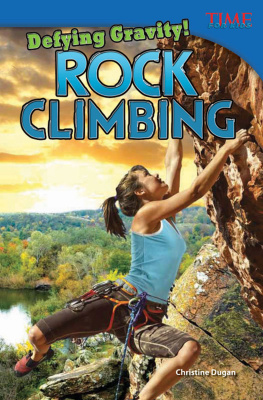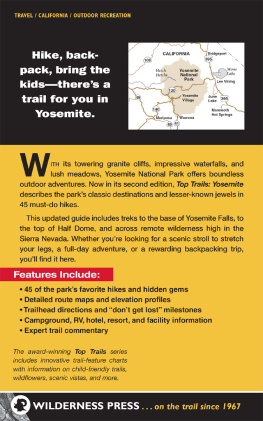CAMP 4
Recollections of a Yosemite Rockclimber

CAMP 4
Recollections of a Yosemite Rockclimber
Steve Roper


Published by
The Mountaineers Books
1001 SW Klickitat Way, Suite 201
Seattle, WA 98134
1994 by Steve Roper
All rights reserved
First cloth printing 1994.
First paper printing 1998, second printing 2004, third printing 2008, fourth printing 2010
No part of this book may be reproduced in any form, or by any electronic, mechanical, or other means, without permission in writing from the publisher.
Distributed in the United Kingdom by Cordee, www.cordee.co.uk
Manufactured in the United States of America
Edited by Linda Gunnarson
Cover design by Kristy L. Welch
Book typesetting and design by The Mountaineers Books
Book layout by Virginia Hand
Cover photograph: Climber and Upper Yosemite Fall (Photo: Galen Rowell/ Mountain Light)
Frontispiece: Stemming up the Meat Grinder, a 5.10 crack route (Photo: Roger Breedlove/Ascent Collection)
Library of Congress Cataloging in Publication Data Roper, Steve.
Camp 4 : recollections of a Yosemite rockclimber / Steve Roper,
p. cm.
Includes bibliographical references (p.) and index.
Cloth: ISBN 089886-3813
Paper: ISBN 089886-5875
1. Rock climbingCaliforniaYosemite ValleyHistory.
2. MountaineersUnited StatesBiography. I. Title. II. Title: Camp Four.
GV199.42.C22Y6763 1994
796.52230979447dc20 943505
CIP
 Printed on recycled paper
Printed on recycled paper
ISBN (cloth): 9780-89886381-9
ISBN (paperback): 9780-89886587-5
ISBN (ebook): 9781-59485282-4
Contents
The seasons still exert their magic, rejuvenating influence on the earth, and the earth is herself, and the Cathedral Rocks and El Capitan still remind you that life is a significant experience, and the smell of bay mixed with pine on an isolated ledge carries nostalgia from another world, yours, one which blacktops and glittering restaurants have failed to invade. Things are unchanged. There is calm.
Mike Borghoff, 1962
Just why is Yosemite climbing so different? Why does it have techniques, ethics and equipment all of its own? The basic reason lies in the nature of the rock itself. Nowhere else in the world is the rock so exfoliated, so glacier-polished, and so devoid of handholds. All of the climbing lines follow vertical crack systems. Every piton crack, every handhold is a vertical one. Special techniques and equipment have evolved through absolute necessity.
Yvon Chouinard, 1963
Preface
I avoided writing this book for many years, thirty to be exact. In my possession is a copy of a wildly enthusiastic letter written to Yosemite pioneer Allen Steck in June 1964: You and I must write the history of Valley climbing! it begins. Youll take the old guys; Ill do the modern stuff. Steck replied cautiously, thinking of the work involved, and our project died after another exchange of letters. Now, of course, Im glad this happened, for Yosemite climbing was still in its infancy in 1964. What if we had written a book when only four routes existed on El Capitan? When Frank Sacherer and Chuck Pratt had not yet begun their mad scramble to eliminate artificial aid from walls big and small? When we had never heard the names Madsen, Schmitz, Hennek, Lauria, Davis, or Kroger?
During the last few years, whenever I told stories about the old days in Camp 4, listeners would beg me to get it down on paper, as if a wine-induced campfire rave could simply be translated word for word into a coherent story. Steck was right: writing a climbing history is a lot of work. This was why I waited, always thinking someone else would do it. No one did. Then, in May 1990, my friend Hugh Swift insisted that I write it down before its too late. Eight months later Hugh died suddenly, on a shockingly ordinary day; he would never write about his beloved Himalaya again. I saw his point; we are mortal, and when we die, a vast storehouse of unique information goes with us.
Other friends pressed me hard also, including Royal Robbins and Jim Sims. But the catalyst was Steck, who, in 1992, casually mentioned to The Mountaineers Books that I was the ideal person to write about the halcyon days of Valley climbing. Donna DeShazo, director of that publishing house, responded within days, catching me off guard with her flattery. Who could resist? To all these people, I owe my thanks: I couldnt have even begun the project without your support.
To put into print the recollections of a bygone era is like traversing unroped along a frightfully exposed ridge. On one side lies the void ruled by the Knave of Embellishment, that devil who whispers, Your storys not that powerful; make it juicier. On the other side of the ridge resides the Champion of Truth, imploring always, Write only whats provable, whats on the record. No writer can deal with personal events without becoming aware of treading this narrow arte. Present beliefs about the past can significantly alter our perceptions of long-ago events. For instance, as a reasonably mature adult, I now find some of my youthful escapades embarrassing. Could I really have been all that crude? And, writing about the old days from a more mature perspective, have I toned down events or overjustified my behavior? All I can say is that Ive tried to tell it like it was.
Many climbers helped me along the path, though any flaws that remain, of course, are mine. The following people dredged their brains for memories, writing extensive letters, chatting at length on the phone, or loaning me diaries or other historical material: Eric Beck, Rich Calderwood, Yvon Chouinard, Nick Clinch, Dave Cook, Mike Corbett, Scott Davis, Bill Dunmire, John Evans, Tom Frost, Morgan Harris, Mort Hempel, Tom Higgins, Al Macdonald, Elaine Matthews, Wayne Merry, Bruce Meyer, John Morton, Royal Robbins, Jan Sacherer, George Sessions, John Shonle, Bill Stall, Allen Steck, Bob Swift, and Frank Tarver.
Others who helped in various ways with information or advice were Jerry Anderson, Eric Brand, Floyd Burnette, Ad Carter, R. D. Caughron, Gerry Czamanske, Jeff Dozier, Jules Eichorn, Joe Fitschen, Jeff Foott, Warren Harding, John Harlin III, Marilyn Harlin, Richard Hechtel, Steve Jervis, Ellen Searby Joli, Chris Jones, Tom Jukes, Bob Kamps, Joe Kelsey, Chuck Kroger, Doris Leonard, Dick Long, Norma Limp, George Meyers, Jim Needham, Wally Reed, Galen Rowell, Lowell Skoog, Claude Suhl, John Thackray, Walt Vennum, Ken Wilson, and Les Wilson.
In addition to sifting through all the information supplied by the above-mentioned people, I obtained contemporary material from the hundreds of letters I received from climbers during the 1950s and 1960s. Somehow I knew these would one day be valuable, and they accompanied me on many a move. Many of the quotes in this book come from these torn and stained letters; some come from interviews; and the majority from those three indispensable journals of the time: Summit, the American Alpine Journal, and the Sierra Club Bulletin. Detailed source information will be found at the end of the book.
Most climbers in the old days didnt own cameras, so it was fortunate that Glen Denny roamed the Valley during the 1960s, taking thousands of black-and-white shots of climbing and climbers. Glen graciously allowed me to sift through his vast collection of negatives, and his splendid portraits of the major Camp 4 players enrich this book in ways that words cannot. Although many of these portraits were taken in the mid- to late sixties, I have often used them to illustrate earlier times.
Next page









 Printed on recycled paper
Printed on recycled paper